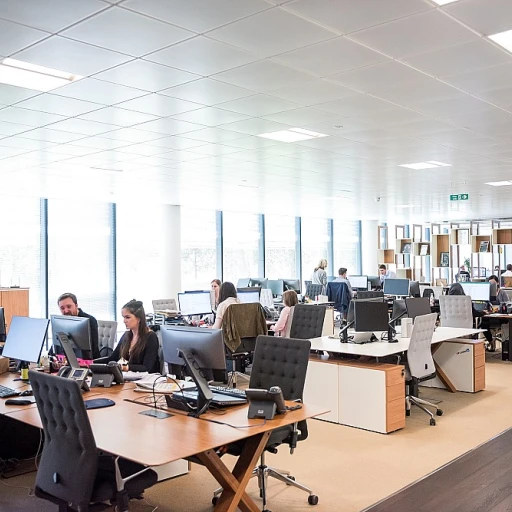
Understanding Structured Workplace Learning
Delving into Structured Learning in the Workplace
Understanding structured workplace learning (SWL) is pivotal for developing a comprehensive approach to employee growth and development. This process involves a systematic arrangement of learning opportunities, closely tied to the world of work, providing a crucial link between students' education and their future careers. Structured workplace learning provides a unique opportunity for students and employers to come together, bridging the gap between theoretical knowledge and practical experience. It typically involves work placements or work based learning that allow students to gain hands on experience, which in turn enhances their employability skills. Employers play a significant role in SWL, offering students real-world exposure and learning opportunities. Through structured training and vocational major placements, young people can develop essential skills that align with industry needs. Schools and educational institutions collaborate with businesses to arrange work placements that are beneficial for both students and employers. The ministerial order surrounding SWL ensures that these learning opportunities are well-structured and assessed, leading to meaningful learning outcomes. It also sets the framework for VCE vocational pathways certificate programs, emphasizing the importance of linking education training with the skills required by industry. While SWL offers significant benefits, as discussed further in the article, it also presents challenges that need to be addressed to ensure successful implementation. For more on how structured learning can benefit workplace performance, refer to our detailed guide on a data-driven approach to enhancing workforce performance here.Benefits of Structured Learning in the Workplace
Unveiling the Advantages of a Structured Learning Environment
Structured workplace learning (SWL) offers numerous advantages for both employees and employers, making it a crucial component in the modern work environment. For employees, SWL creates a framework where they can effectively enhance their skills, while also benefitting educational pathways like VCE Vocational Major. Firstly, structured learning in the workplace ensures that young people gain valuable work experience. These opportunities allow students to transition smoothly from school work to professional work placements, effectively bridging the gap between education and employment. For employers, structured learning provides an opportunity to mold future employees by integrating them into industry work placements. This not only helps in identifying potential talents but also in assessing the student's suitability through real-life work-based learning experiences. The inclusion of ministerial orders further adds credibility, ensuring quality assurance in the placement and training processes. Structured programs also promote continuous learning, essential for maintaining an adaptable and skilled workforce. In addition, structured workplace learning is instrumental in offering students a chance to put theoretical knowledge into practice. The hands-on experience significantly enhances learning outcomes, as students apply school-taught skills in a real-world industry context. Effective SWL programs also facilitate practical skill assessment, providing critical feedback to students and educational institutions, which helps in refining educational curriculums and training methods. Overall, structured workplace learning fosters a symbiotic relationship between schools, students, and employers, creating a win-win situation where everyone benefits from the enhanced learning structure, leading to a more competent and confident workforce. For more insights on the topics of learning and workplace efficiency, you might consider reading about effective questions for skip-level meetings.Implementing Structured Learning Programs
Designing Effective Programs for Skill Enhancement
Implementing structured learning programs in the workplace requires a strategic approach to ensure students and employees gain maximum benefit from their experiences. To start, organizations should conduct a comprehensive assessment of current training needs and skill gaps. This assessment will provide a foundation for designing relevant and impactful training modules. One effective method is integrating work-based learning opportunities, where employees and young people can gain practical industry experience. Structured workplace learning (SWL) is particularly beneficial, as it combines theoretical education from schools with real-world workplace placements, offering students opportunities to apply their knowledge in actual work settings. To streamline the implementation process, several key components should be considered:- Clear Learning Objectives: Defining specific outcomes for each training session helps maintain focus and ensures education training is aligned with organizational goals.
- Industry Collaboration: Partnering with employers and educational institutions enhances the relevance of SWL programs. Collaboration often results in tailored training experiences that meet both industry standards and the learning outcomes expected by vocational major pathways.
- Supportive Learning Environment: Creating an inclusive environment encourages engagement and facilitates skill acquisition. This can be achieved by offering diverse learning opportunities and accommodating different student education and workplace learning styles.
- Continuous Feedback and Assessment: Regular evaluations of student progress and training effectiveness help refine programs based on real-time data. Feedback allows for adjustments to ensure that work placements provide valuable experiences that translate into skill growth.
Measuring the Impact of Structured Learning
Evaluating the Effectiveness of Learning Strategies
Measuring the impact of structured workplace learning involves assessing various elements. It's crucial for employers and education institutions to evaluate whether the learning opportunities provided are yielding positive outcomes.- Learning Outcomes: Assessing the achievements of students and young people post-training is essential. Are they gaining the necessary skills and competencies aligned with industry requirements?
- Pathways Certificate: Monitoring students’ progress through pathways certificates can indicate the effectiveness of both the learning content and methodology involved in swl.
- Employer Feedback: Collecting feedback from employers involved in work placements provides real-world insights into how well the structured education translates into workplace performance.
- Student Assessment: Regular and thorough assessment of student progress during placements is vital. Their performance can illuminate areas where structured learning needs enhancement.
- Education and Training Metrics: Utilizing quantitative and qualitative metrics related to vocational majors and vce vocational programs helps in refining learning strategies for future placements.
Challenges in Structured Workplace Learning
Addressing Challenges in Tailoring SWL to Diverse Needs
Creating effective structured workplace learning programs often requires overcoming several hurdles. One of the key challenges is addressing the diverse needs of the work experience, including students, employers, and education institutions such as schools. Every participant in these processes, be they students or industry professionals, has unique expectations and requirements that must be acknowledged.Balancing Educational Goals with Industry Demands
An essential balance must be struck between the academic objectives of students and the practical needs of employers. While young people participating in SWL are often eager to gain real-world skills and enrich their education training through work placement, employers focus on achieving tangible results from their work placement programs. Moreover, the values and preferences affecting employee skills development often differ between academic and vocational major pathways. Aligning these differing priorities can be a complex undertaking but is critical for the successful implementation of work based learning and development.Securing Proper Assessment Tools and Methodologies
Structured workplace learning programs also contend with the challenge of developing coherent assessment strategies. Valid assessment tools are crucial to accurately evaluate learning outcomes and ensure the effectiveness of the placement. Such assessment should ideally align with ministerial order protocols to validate students’ experiences and pave the way for robust education outcomes. Employers and schools must therefore collaborate continuously to design assessment methodologies that can capture the insights needed to determine the success of education training and the benefits derived from work experience programs. Without comprehensive assessment, structured learning opportunities may fail to meet their full potential.Managing Logistical and Administrative Complexities
Finally, managing the logistics and administrative duties of SWL programs presents its own set of challenges. Arranging seamless placements often involves complex paperwork, coordination with multiple parties, and adherence to legislation. For example, the arrangement form between schools and employers plays a critical role in defining the structure and expectations of work placements. These arrangements must be meticulously planned and communicated to prevent misunderstandings and ensure smooth operation. As students transition from school-based learning environments into the workplace, managing these administrative tasks becomes an essential part of delivering effective structured workplace learning experiences.Future Trends in Workplace Learning
Emerging Trends in Workplace Learning
The landscape of workplace learning is rapidly evolving, driven by technological advancements and changing workforce dynamics. As organizations strive to enhance employee skills, several trends are shaping the future of structured workplace learning.
- Integration of Technology: The use of digital tools and platforms is becoming increasingly prevalent in structured learning programs. Technologies such as virtual reality (VR) and augmented reality (AR) are providing immersive learning experiences, allowing employees to gain practical skills in a controlled environment.
- Personalized Learning Paths: With the rise of data analytics, organizations can now tailor learning experiences to individual needs. This approach not only boosts engagement but also ensures that learning outcomes align with personal and organizational goals.
- Focus on Soft Skills: While technical skills remain crucial, there is a growing emphasis on developing soft skills such as communication, teamwork, and problem-solving. These skills are essential for adapting to the dynamic nature of modern workplaces.
- Collaboration with Educational Institutions: Partnerships between businesses and schools are becoming more common, providing students with work placements and real-world experience. This collaboration helps bridge the gap between education and industry, preparing young people for future careers.
- Continuous Learning Culture: Organizations are fostering a culture of continuous learning, encouraging employees to seek out new learning opportunities and stay updated with industry trends. This shift is crucial for maintaining a competitive edge in a rapidly changing market.
As these trends continue to develop, the role of structured workplace learning will become even more integral to organizational success. By staying ahead of these changes, employers can create a more skilled and adaptable workforce, ready to meet the challenges of the future.












